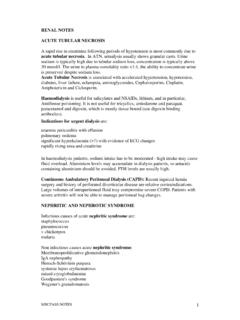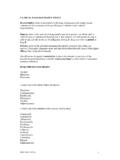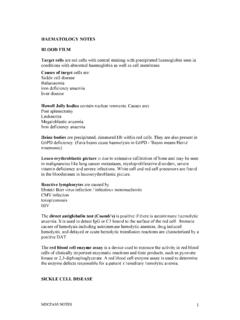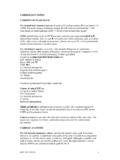Transcription of ENDOCRINOLOGY NOTES PITUITARY DISORDERS IGF-1
1 ENDOCRINOLOGY NOTES PITUITARY DISORDERS Growth Hormone usually decreases following an elevation in blood glucose after a meal. It is usually increased during sleep or during starvation. It causes both retention of sodium and potassium which are required for growth metabolism. Elevated GH levels increase IGF-1 blood levels. Because IGF-1 levels are much more stable over the course of the day, they are often a more practical and reliable measure than GH levels. Elevated IGF-1 levels almost always indicate acromegaly.
2 The oral glucose tolerance test is also used to diagnose acromegaly, because ingestion of 75 g of the sugar glucose lowers blood GH levels less than 2 ng/ml in healthy people. In patients with acromegaly, this reduction does not occur. In acromegaly, hypertension, diabetes and goitre are associated. A damaged PITUITARY stalk reducing the dopamine suppression signal, stimulates prolactin secretion. Pseudogout (calcium pyrophosphate deposition) is also associated. Patients have normal calcium but increased phosphate levels.
3 Patients with acromegaly have an increased risk of colorectal neoplasia. The best treatment option for a large PITUITARY tumour in acromegaly is transphenoidal removal of the tumour. Octreotide (somatostatin analogue) and pegvisomant (growth hormone receptor blocker) are effective forms of treatment. Bromocriptine (dopamine agonist) is less effective. Prolactin secretion is inhibited by dopaminergic pathway. Hyperprolactinaemia can be caused by Dopamine receptor antagonists (many antipsychotic drugs phenothiazines, risperidone), hypothyroidism, liver or renal failure, PITUITARY adenoma /acromegaly.
4 It leads to galactorrhoea and osteoporosis/osteopenia. Treatment is with dopamine receptor agonists (bromocriptine, cabergoline). Microprolactinoma: The most frequent symptoms at onset are oligoamenorrhoea (60%) and galactorrhoea (50%), and headaches. Treatment is with bromocriptine ( 5 mg od). Cushing's syndrome is a non-specific name for any source of excessive glucorticoids. There are four main causes: 1) Exogenous glucocorticoids 2) PITUITARY Cushing s syndrome known as Cushing s disease, due to a PITUITARY adenoma secreting excessive ACTH 3) Ectopic production of ACTH.
5 Two varieties; one due to malignant tumours usually of the lung , these patients present with hypertension, hypokalaemia and hyperpigmentation. The second type is due to carcinoid tumours. In the dexamethasone suppression test normal individuals suppress cortisol levels to < 50 nmol/L. MRCPASS NOTES 1 The inferior petrosal sinus sampling test, an elevated central ACTH concentration compared to a peripheral value (from arm veins) indicates PITUITARY dependent Cushing's disease. The test involves a microcatheter being advanced through initially the femoral vein and eventually into the inferior petrosal sinuses which lie along the internal aspect of the skull base which drain blood from the PITUITARY gland.
6 Metyrapone is an inhibitor of 11 beta hydroxylase, inhibiting the conversion of 11 deoxycortisol to cortisol, and can be used as treatment in Cushing s syndrome. In ectopic ACTH syndrome, hypokalaemic alkalosis is typical. Ectopic ACTH is not suppressed by high doses of steroids such as 8 mg dexamethasome. It is typically caused by small cell carcinoma of the lung. Thymoma, carcinoid tumour, medullary carcinoma of the thyroid, pancreatic carcinoma and phaeochromocytoma are associated with ectopic ACTH secretion.
7 PITUITARY apoplexy is characterized by sudden onset of headache, visual symptoms, confusion and hormonal dysfunction due to acute hemorrhage or infarction of a PITUITARY gland. The PITUITARY gland is susceptible to infarction during pregnancy due to its increased size/blood flow. Hyponatraemia, hyperkalaemia and hypoglycaemia are as a result of secondary adrenal failure due to lack of ACTH. Clomiphene is used as a fertility drug in hypopituitarism. It stimulates ovulation through the release of gonadotropins from the PITUITARY gland.
8 It can also be used in PCOS and in treating male infertility. DIABETES A random glucose of > and a fasting glucose of > mmol/L (two occasions) would confirm the diagnosis . Diabetic neuropathy Autonomic neuropathy to the gut, bladder and sexual organs (impotence) can occur. A 3rd nerve mononeuropathy can occur. Motor neuropathy can cause muscle wasting, and sensory neuropathy causes vibration sensory loss. In diabetic patients with microalbuminaemia demonstrated on urine dipstick, ACE inhibitors have been shown to reduce progression towards diabetic nephropathy.
9 Aggressive hypertension control is the best way of preventing progression from microalbuminuria to macroalbuminuria. Although glycaemic control is important, it is not as important as hypertensive control in preventing progression towards nephropathy. According to NICE guidelines, target of HbA1c is , BP target is 135/75, albumin:creatinine target is ratio > (men) and > (women), renal consult advised if creat >150, and ACE inhibitor should be introduced to those with microalbuminuria. MRCPASS NOTES 2In diabetics who have had an MI, the DIGAMI study showed that intravenous insulin for 24 hours and subcutaneous insulin for 3 months improved mortality rates for up to 3 years after.
10 Metformin is a biguanide. It improves insulin sensitivity and is helpful especially in patients who are overweight as it does not stimulate appetites in the way that sulphonylureas do. Hyperosmolar non ketotic coma is characterised by markedly raised blood sugar, often >50 mmol/L. There is no significant ketosis and acidosis. It occurs in patients with Type 2 diabetes of middle age or older. Treatment should be with isotonic saline , low dose insulin and potassium replacement. Syndrome X describes a range of abnormalities often seen with insulin resistance.



